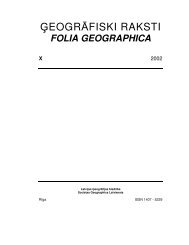eogrÄfiski raksti folia geographica xii - Ä¢eogrÄfijas un Zemes zinÄtņu ...
eogrÄfiski raksti folia geographica xii - Ä¢eogrÄfijas un Zemes zinÄtņu ...
eogrÄfiski raksti folia geographica xii - Ä¢eogrÄfijas un Zemes zinÄtņu ...
You also want an ePaper? Increase the reach of your titles
YUMPU automatically turns print PDFs into web optimized ePapers that Google loves.
DEVELOPMENT OF PLACES AND REGIONS<br />
Department of Tourism <strong>un</strong>der the auspices of the co<strong>un</strong>try’s Economics Ministry was an<br />
important step forward. In 2004 the government awarded 2.5 times more money from the<br />
national budget to the tourism sector than had been the case in the previous year –<br />
LVL 1.04 million (about 1.6 million euros) in all. Of this sum, 63% of the money is to be used<br />
for marketing activities.<br />
In 2003 foreign travellers in Latvia spent a total of LVL 124.4 million (about 190 million<br />
euros). The average Latvian traveller spends 3.6 24-hour periods when travelling to another<br />
co<strong>un</strong>try, while the foreign travellers who come to Latvia spend only an average of 1.9 24-hour<br />
periods here – nearly two times less. The international balance in this area, therefore, is negative<br />
by LVL 58 million in 2003.<br />
As far as in-co<strong>un</strong>try tourism is concerned, 52% of Latvia’s residents have said that they<br />
take at least one trip within Latvia each year. Latvia is a small co<strong>un</strong>try and 82% of the trips have<br />
been day trips without overnight accommodations [LR CSP/CSBL 2003].<br />
Until the end of the 20 th century most of Latvia’s tourism offers involved cultural and<br />
historical resources fo<strong>un</strong>d in the cities of Riga, Cēsis, Sigulda, and Kuldīga, as well as the resort<br />
town of Jurmala. Over the last few years tourism has developed in other cities as well. Cities<br />
have also become centres for business-related travel. Congress and conference centres,<br />
amusement parks, festivals, exhibitions, annual fairs, and other events attract people. Statistics<br />
show that Jurmala and Riga continue to be the primary destinations for in-co<strong>un</strong>try tourism<br />
(attracting 23% and 22% of all trips respectively) [LR CSP/CSBL 2003]. As far as business<br />
travel is concerned, Riga attracts 35% of the trips, but other destinations include Ventspils (8%)<br />
and Liepaja (5%).<br />
Development of marketing images for cities<br />
People in any city, any location have images of these places. The image represents the<br />
impression, which people have gained about the specific geographic location through the<br />
process of perception and cognition. It is made up of the sum of beliefs, views, and impressions<br />
[Gartner 2000]. We can separate out the organic image – the one that is the result of one’s<br />
experience of things that one has read or heard about the place or gained from a visit to the<br />
location. Marketers of cities, however, talk about the induced image – the one that is<br />
purposefully created and aimed at a specific target audience through marketing resources and<br />
activities. In an urban development process, this image can change radically, but the city’s<br />
original image can still remain in the public mind for a long time to come. In terms of human<br />
perceptions, the image is much more important than the reality. A city’s image can be<br />
purposefully put together and nurtured as a marketing instrument, attracting financial interest<br />
and then be further developed. An image that is negative or that has been developed without<br />
skill can create obstacles and hindrances to a city’s development. When a city is faced with an<br />
incorrect, false or <strong>un</strong>desirable image, it needs to renew and reposition that image. Major events<br />
or the creation of a new and attractive environment within the city can facilitate this process<br />
[Tyler, Guerrier 1998].<br />
The brand of a city is one of the elements in creating its image. According to specialists<br />
this is one of the most important marketing resources for positioning a city in the tourism<br />
market, because there are a great many locations with similar product and service offerings. The<br />
battle takes place not only in the marketplace, but also in the minds and hearts of travellers<br />
[Morgan, Pritchard 2002]. The way in which a city’s brand is developed is no different than the<br />
way in which brands are developed for consumer goods. First of all, the values of the city must<br />
be studied. These must be long-term, sustainable, permanent and attractive. They must be<br />
managed in order to determine the <strong>un</strong>iqueness of the brand. Once the values have been defined,<br />
the purpose of marketing is to confirm and supplement them, particularly in written text and<br />
images. The brand values must be characteristic, all encompassing, easily perceived,<br />
<strong>un</strong>derstood, and remembered. They must be presented through a logo or slogan, there must be a<br />
certain style to the message so as to ensure that the information is presented in a way that can be<br />
easily received. Brands which aim to conjure up emotions must be believable, easily perceived,<br />
focused on the most typical elements of the city (product), presented through powerful ideas,<br />
exciting for business partners, and in line with consumer desires [Morgan, Pritchard 2000].<br />
76

















